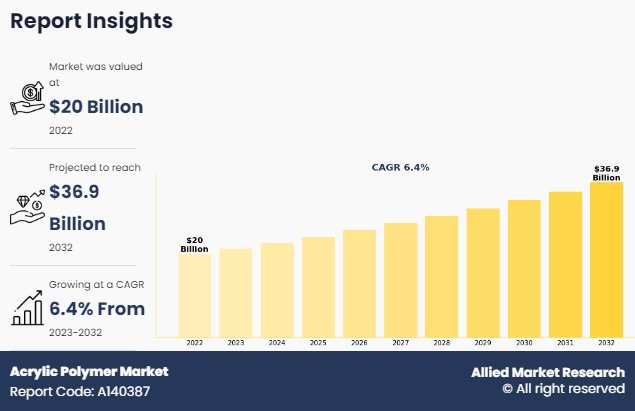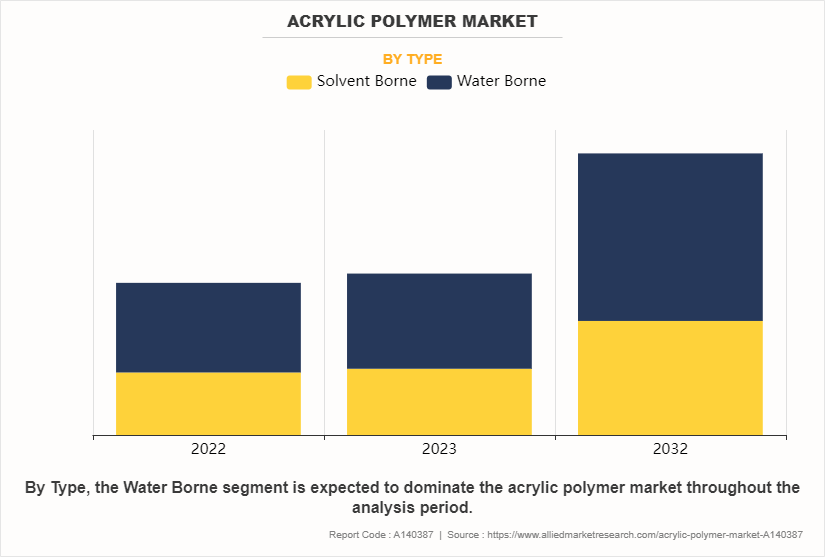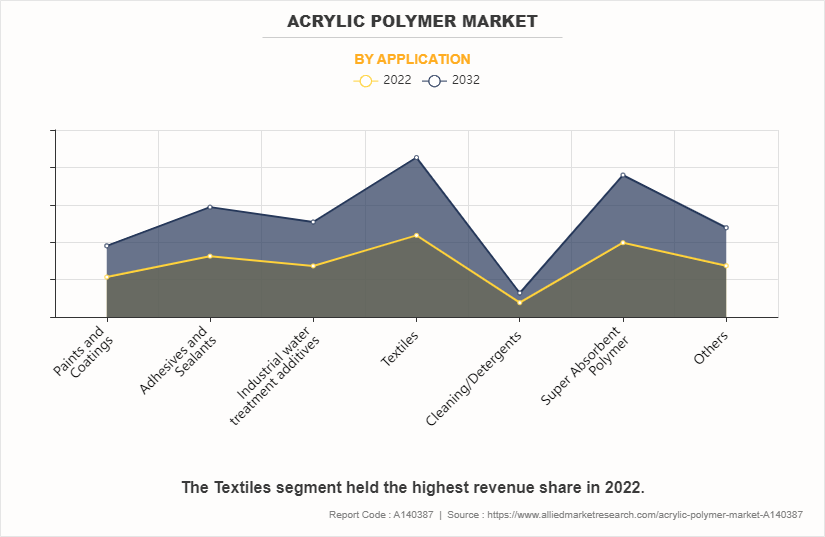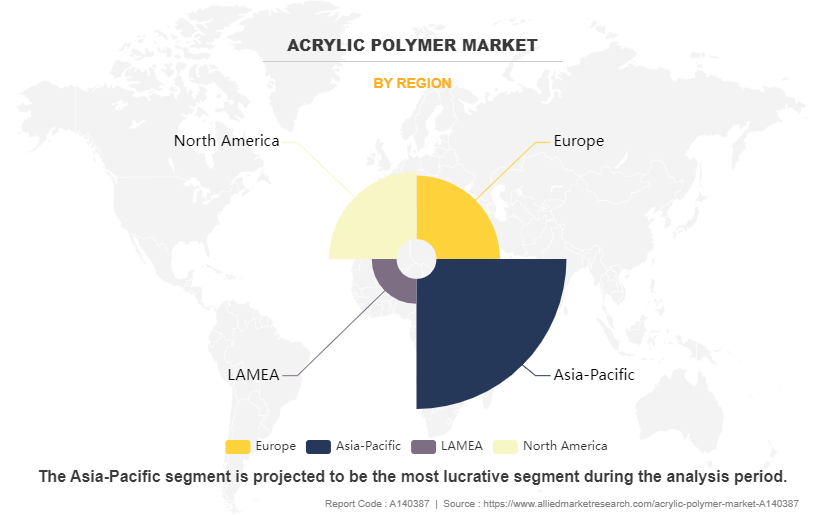Acrylic Polymer Market Overview
The global acrylic polymer market was valued at USD 20.0 billion in 2022, and is projected to reach USD 36.9 billion by 2032, growing at a CAGR of 6.4% from 2023 to 2032.
Acrylic polymer is a versatile material derived from acrylic acids. Its molecular structure consists of long chains of carbons with ester side groups. Acrylic polymers exhibit remarkable clarity, resembling glass-like transparency. They are highly resistant to UV light, making them suitable for outdoor applications. Additionally, these polymers can withstand exposure to various chemicals. In construction, acrylic polymers enhance the strength and durability of concrete mixtures. Overall, acrylic polymers play a crucial role in modern construction practices, whether used in concrete, coatings, adhesives, or paints, thus contributing to stronger and more sustainable infrastructures. Moreover, other applications of acrylic polymer include textile, water treatment, super absorbent polymer, adhesives and coatings, and others.

Key Takeaways:
- The report provides competitive dynamics by evaluating business segments, product portfolios, target market revenue, geographical presence and key strategic developments by prominent manufacturers.
- The acrylic polymer market is fragmented in nature among prominent companies such as Dow Inc., BASF SE, Arkema, DuPont, Mitsui Chemicals, Inc., NIPPON SHOKUBAI. CO. LTD, The Lubrizol Corporation, Ashland Inc, TOAGOSEI CO., LTD., and Sumitomo Chemical Co., Ltd.
- The study contains qualitative information such as the market dynamics (drivers, restraints, challenges, and opportunities), public policy analysis, pricing analysis, and Porters Five Force Analysis across North America, Europe, Asia-Pacific, LAMEA regions.
- Latest trends in global acrylic polymer market such as undergoing R&D activities, regulatory guidelines, and government initiatives are analyzed across 16 countries in 4 different regions.
- More than 3,200 acrylic polymer-related product literatures, industry releases, annual reports, and other such documents of key industry participants along with authentic industry journals and government websites have been reviewed for generating high-value industry insights for global acrylic polymer market.
Market Dynamics:
Growth in population coupled with rapid urbanization has surged the growth of the building & construction sector in both developed and developing economies, where acrylic polymers-based paints and coatings are widely used for flooring, wall finishing, and roofing applications. This is expected to boost the demand for the acrylic polymers market in the booming building & construction sector. In addition, strong economic growth has surged the establishments of industries where acrylic coatings are used as a protective coating for washers, driers, steel pipes, fittings, structural inserts, and industrial equipment. This is expected to propel the growth of the acrylic polymers industry.
However, volatility in prices of acrylic polymer is expected to hamper the growth of the acrylic polymers market during the forecast period. On the contrary, the rapid growth of additive manufacturing, also known as 3D printing, presents a significant opportunity for the acrylic polymers market. Acrylic polymers are well-suited for additive manufacturing processes due to their excellent melt flow characteristics, thermal stability, and compatibility with various 3D printing technologies such as fused deposition modeling (FDM) and stereolithography (SLA). Acrylic-based filaments and resins are widely used in 3D printing applications for prototyping, product development, and custom manufacturing of complex parts and components. With ongoing advancements in 3D printing technology, materials, and software, there are vast opportunities for acrylic polymer manufacturers to innovate and develop specialized materials tailored to the unique requirements of additive manufacturing applications.
Segment Overview:
The acrylic polymers market is segmented on the basis of type, application, and region. On the basis of type, the market is categorized into solvent borne and water borne. By application, the market is divided into paints and coatings, adhesives and sealants, industrial water treatment additives, textiles, cleaning/detergents, super absorbent polymer, and others. Region-wise, the market is studied across North America, Europe, Asia-Pacific, and LAMEA.

In 2022, the water borne segment was the largest revenue generator, and is anticipated to grow at a CAGR of 6.5% during the forecast period. Stricter environmental regulations regarding volatile organic compounds (VOCs) and hazardous air pollutants (HAPs) drive the demand for environmentally friendly coatings and adhesives. Waterborne acrylic polymers have low VOC content as compared to solvent-based alternatives, making them compliant with regulations and suitable for green building standards. Furthermore, waterborne acrylic polymers offer improved health and safety benefits compared to solvent-based counterparts. They have lower toxicity levels, reduced flammability, and emit fewer harmful fumes during application, contributing to safer working environments for manufacturers, applicators, and end-users.

By application, the textiles segment dominated the global market in 2022, and is anticipated to grow at a CAGR of 7.0% during forecast period. Acrylic polymers offer desirable properties for textile applications, including softness, warmth, and resilience. Acrylic fibers can mimic the look and feel of natural fibers like wool while offering enhanced durability and colorfastness. They also have excellent resistance to sunlight, mildew, and chemicals, making them suitable for outdoor and industrial textiles. Furthermore, they provide a cost-effective alternative to natural fibers such as wool and cashmere. They can be produced at a lower cost and in greater quantities, making them accessible for a wide range of textile applications, including apparel, upholstery, carpets, and outdoor fabrics.

The Asia-Pacific acrylic polymers market size is projected to grow at the highest CAGR of 6.9% during the forecast period and accounted for 45.5% of the acrylic polymers market share in 2022. The Asia-Pacific region has experienced rapid economic growth over the past few decades, leading to increased industrialization, urbanization, and consumer spending. This economic expansion has driven demand for acrylic polymers in various sectors such as construction, automotive, electronics, textiles, and packaging. Additionally, many countries in the Asia-Pacific region are investing heavily in infrastructure development, including construction of buildings, roads, bridges, and transportation networks. Acrylic polymers are used in a wide range of construction materials such as paints, coatings, adhesives, sealants, and waterproofing compounds, driving demand for these products.
Competitive Analysis:
The global acrylic polymers market profiles leading players that include Dow Inc., BASF SE, Arkema, DuPont, Mitsui Chemicals, Inc., NIPPON SHOKUBAI. CO. LTD, The Lubrizol Corporation, Ashland Inc, TOAGOSEI CO., LTD., and Sumitomo Chemical Co., Ltd. The global acrylic polymers market report provides in-depth competitive analysis as well as profiles of these major players.
Key Benefits For Stakeholders
This report provides a quantitative analysis of the market segments, current trends, estimations, and dynamics of the acrylic polymer market analysis from 2022 to 2032 to identify the prevailing acrylic polymer market opportunities.
The market research is offered along with information related to key drivers, restraints, and opportunities.
Porter's five forces analysis highlights the potency of buyers and suppliers to enable stakeholders make profit-oriented business decisions and strengthen their supplier-buyer network.
In-depth analysis of the acrylic polymer market segmentation assists to determine the prevailing market opportunities.
Major countries in each region are mapped according to their revenue contribution to the global market.
Market player positioning facilitates benchmarking and provides a clear understanding of the present position of the market players.
The report includes the analysis of the regional as well as global acrylic polymer market trends, key players, market segments, application areas, and market growth strategies.
Acrylic Polymer Market Report Highlights
| Aspects | Details |
| Market Size By 2032 | USD 36.9 billion |
| Growth Rate | CAGR of 6.4% |
| Forecast period | 2022 - 2032 |
| Report Pages | 331 |
| By Type |
|
| By Application |
|
| By Region |
|
| Key Market Players | NIPPON SHOKUBAI. CO. LTD, The Lubrizol Corporation, Sumitomo Chemical Co., Ltd., Dow Inc., Ashland Inc, Mitsui Chemicals, Inc., TOAGOSEI CO., LTD., BASF SE, DuPont, Arkema |
Analyst Review
According to CXOs of leading companies, the global acrylic polymers market offers significant growth potential, especially with increasing demand across industries such as construction, automotive, and healthcare. As markets evolve and new applications emerge, acrylic polymer technology can drive innovation and revenue growth.
In addition, leveraging acrylic polymers effectively can provide a competitive edge by offering superior product performance, durability, and cost-effectiveness compared to alternatives. Investing in research and development to improve acrylic polymer formulations can reinforce the company's market position.
With growing environmental concerns, CXO's are increasingly focused on sustainability. Acrylic polymers can be engineered to be eco-friendly, bio-based, or recyclable, aligning with corporate sustainability goals and enhancing brand reputation
Furthermore, CXOs are more focused on optimizing manufacturing processes, supply chain logistics, and quality control to ensure consistent production of high-quality acrylic polymers. Continuous improvement initiatives, automation, and lean practices enhance efficiency and reduce costs. CXOs further added that sustained economic growth and development of the paints and coatings manufacturing, water treatment, textile, and other sectors have increased the popularity of acrylic polymers.
Escalating demand from architecture sector, robust demand from the automotive sector, rise in preference for water-based acrylic coatings, rise in demand from packaging sector, growth in textile sector are the upcoming trends of acrylic polymer Market in the world.
Textile is the leading application of Acrylic Polymer Market.
Asia-Pacific is the largest regional market for Acrylic Polymer.
The acrylic polymers market was valued at $20.0 billion in 2022 and is estimated to reach $36.9 billion by 2032, exhibiting a CAGR of 6.4% from 2023 to 2032.
Dow Inc., BASF SE, Arkema, DuPont, Mitsui Chemicals, Inc., NIPPON SHOKUBAI. CO. LTD, The Lubrizol Corporation, Ashland Inc, TOAGOSEI CO., LTD., and Sumitomo Chemical Co., Ltd. are the top companies to hold the market share in Acrylic Polymer.
Loading Table Of Content...
Loading Research Methodology...



